Menus
- Legends celebrate an anniversary
- Harley-Davidson Electra Glide – 50 years!
- Historic Electra Glide looks simpler
- Be a man, ride a pan!
- Press the button once and the injector is there
- A statement on wheels
- Brakes? What brakes?
- Technical data Harley-Davidson Electra Glide
- The facts:
- Honda Gold Wing – 40 years!
- Sound is reminiscent of VW Beetles
- Sports tourers or super athletes?
- A real beauty, this Honda GL 1000 Gold Wing
- The original version reacts much more sensitively in an inclined position
- Technical data Honda Gold Wing
- The facts:
- Yamaha Vmax – 30 years!
- V4 needs some choke
- Mechanically, the V4 sounds completely healthy, never strained
- 2.7 seconds for the sprint from 0 to 100
- The 1700 is sturdy on the track
- Technical data Yamaha Vmax
- The facts:
- Conclusion
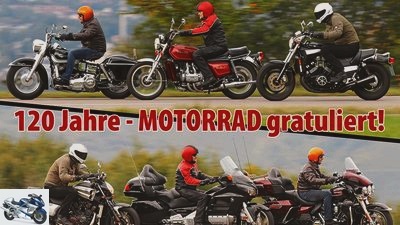
Bilski
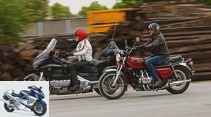
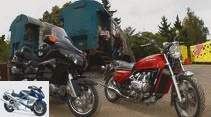
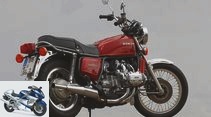
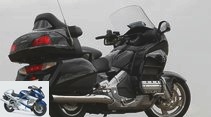
48 photos
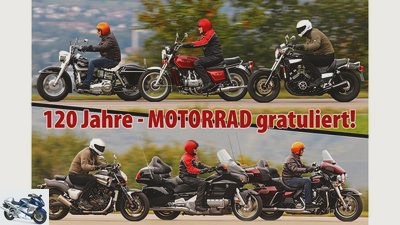
Bilski
1/48
Three rolling icons, sculptures on wheels, celebrate 2015 rounds
Birthday. Motorcycles that almost everyone knows, together a full 120 years of cult. MOTORRAD congratulates.
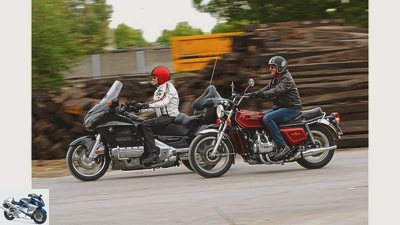
Bilski
2/48
Honda Gold Wing.
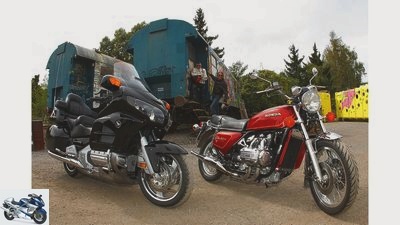
Bilski
3/48
Gold Wing is more than a name. It’s a touring dream on wheels. With their appearance, anything was possible in the motorcycle world, including absolute reliability. At first, the 1000 was misunderstood as an athlete.
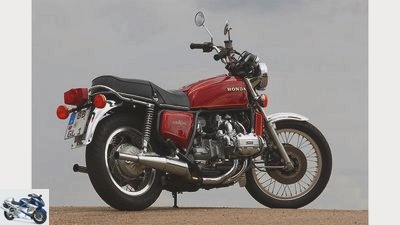
Bilski
4/48
Honda Gold Wing 1000 (1975).

Bilski
5/48
Honda Gold Wing (2015).
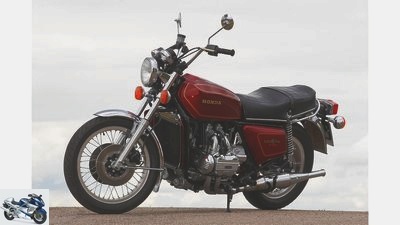
Bilski
6/48
Honda Gold Wing 1000 (1975).
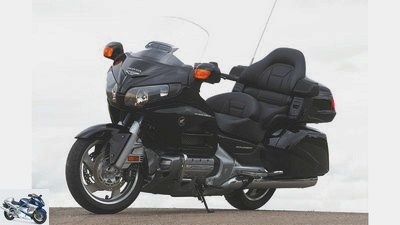
Bilski
7/48
Honda Gold Wing (2015).
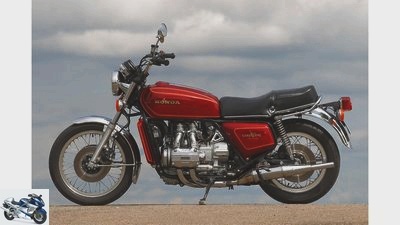
Bilski
8/48
Honda Gold Wing 1000 (1975).
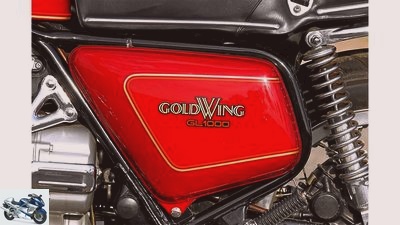
9/48
Creed: The golden wing has now found hundreds of thousands of fans.
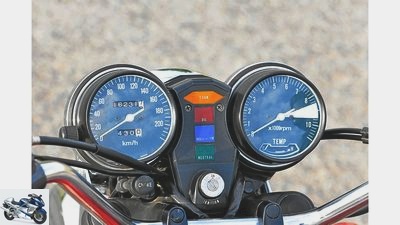
10/48
Top: round clocks with thin pointers, cooling water thermometer and choke on the handlebar.
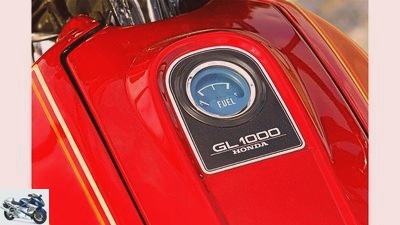
11/48
The fuel gauge is on top of the dummy fuel tank.
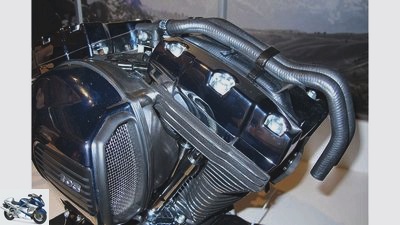
Blacksmith
12/48
Harley-Davidson Electra Glide Ultra Limited (2015): Keep cool: Since 2013, well-hidden, cooling water has been lapping your heads.

Gargolov
13/48
Harley-Davidson Electra Glide Ultra Limited (2015): Trademark: characteristic 45-degree V2 with lots of chrome and long bumpers.
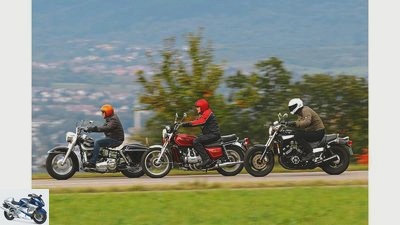
Bilski
14/48
Three motorcycles, three legends.
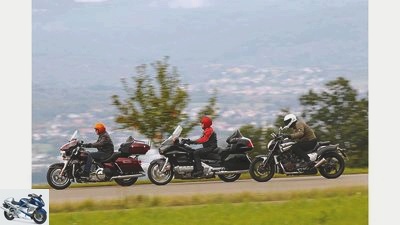
Bilski
15/48
We look at the development of the Harley-Davidson Electra Glide, Honda Gold Wing and Yamaha Vmax.
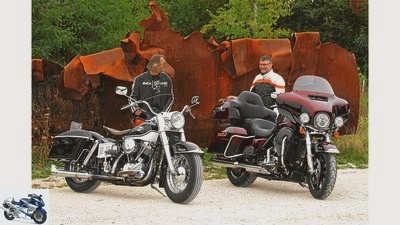
Bilski
16/48
Harley Davidson Electra Glide: Tradition and style have shaped motorcycles from Milwaukee since 1903. And the Electra Glide has been an icon for half a century. It is regarded as the epitome of the American Dream on two wheels and is probably the most famous motorcycle in the world.
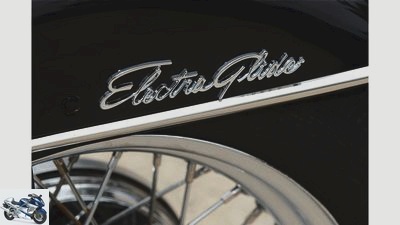
Bilski
17/48
Harley Davidson Electra Glide (1965): Creed: the most famous model of the most famous motorcycle brand in the world.
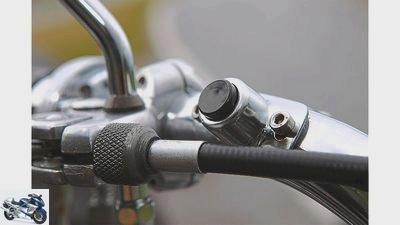
Bilski
18/48
Harley Davidson Electra Glide (1965): The button of buttons: The additional electric starter opened up new customers for Harley.
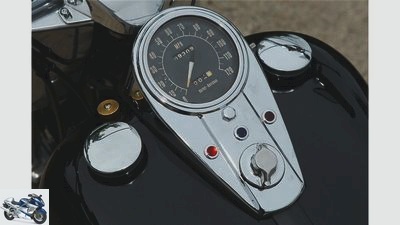
Bilski
19/48
Harley Davidson Electra Glide (1965): instrument panel with rotary switch, two tank filler necks, brass fuel tap.
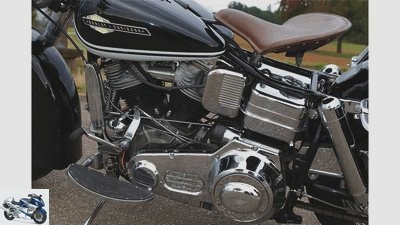
Bilski
20/48
Harley Davidson Electra Glide (1965): redirection of the hand clutch (left), huge battery box, struts, duplex chain.
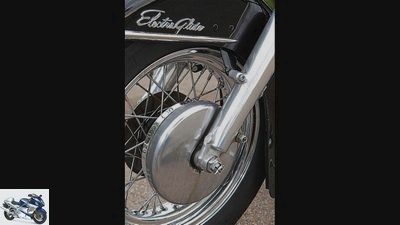
Bilski
21/48
Harley Davidson Electra Glide (1965): Overstrained: The half-hub drum is not a brake according to today’s understanding.
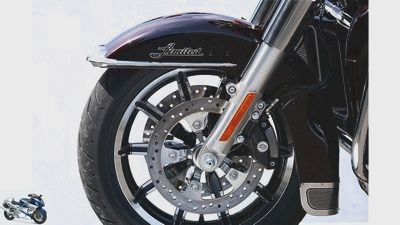
Gargolov
22/48
Harley-Davidson Electra Glide Ultra Limited (2015): Effective: Modern composite brakes stop as if from another galaxy.

Gargolov
23/48
Harley-Davidson Electra Glide Ultra Limited (2015).
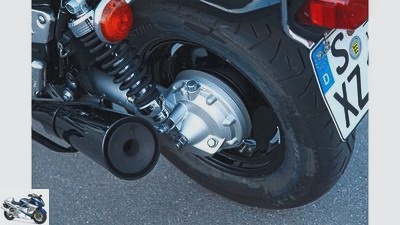
Blacksmith
24/48
Somehow 80s: Cardan, stereo struts and disc wheel with balloon tires.
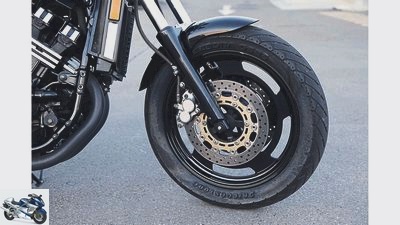
25/48
Improved since 1993: More powerful brakes and thicker fork tubes increased driving safety.
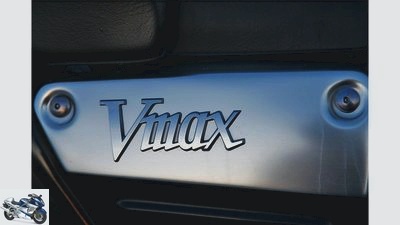
Blacksmith
26/48
Promising: Since 1985, Vmax has not meant top speed, but maximum V4 power.

Bilski
27/48
In itself, the drag strip race, the full acceleration over the quarter mile (402 meters), is a quintessentially American type of motor sport. But just a production motorcycle from Japan was perfect: the Yamaha Vmax. It turns on in Europe too.
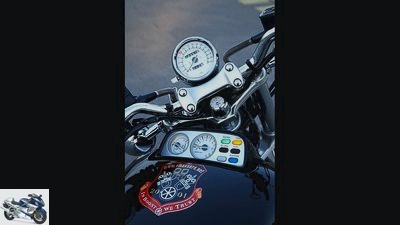
Blacksmith
28/48
Speedometer on the handlebars, tour counter / thermometer on dummy tank.

Bilski
29/48
The granddaughter doesn’t necessarily do it differently, but at least digitally: The new Vmax reports the fuel level and the gear that is engaged …
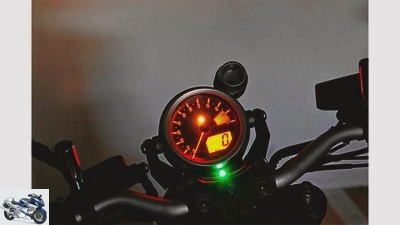
Bilski
30/48
… Tachometer and shift light dominate the handlebars.
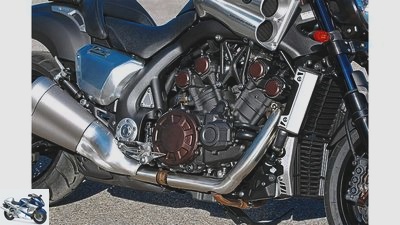
Blacksmith
31/48
Cathedral of power: the 65-degree V4 was the first production engine to officially develop 200 hp. Heat dissipation? Cooler, the size of Monaco.
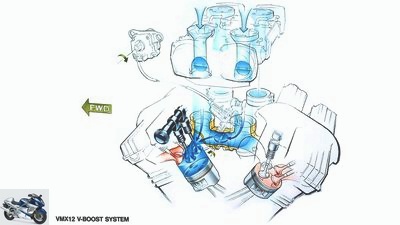
Yamaha
32/48
Strong: The “Boost”, the connection of the intake paths of both cylinder banks, gets you moving from 6000 rpm.
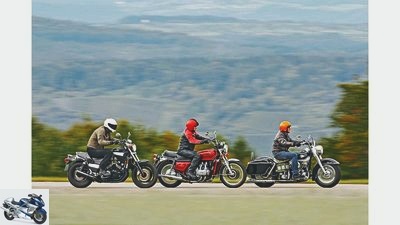
Bilski
33/48
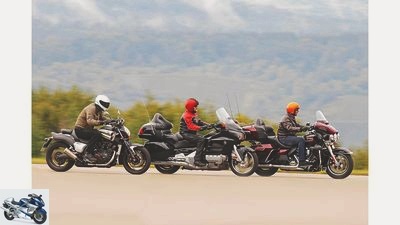
Bilski
34/48
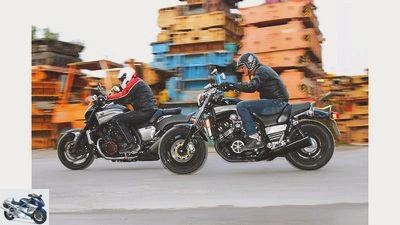
Bilski
35/48
30 years of Yamaha Vmax.
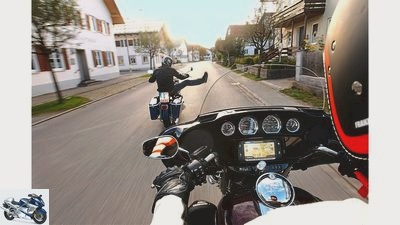
Bilski
36/48
When the blinker wasn‘t invented yet? The narrow rear of the 65 E-Glide dictated the characteristic shape of the case. A nice watch collection, great loudspeaker sound and XXL touchscreen with navigation system are on board today.

Bilski
37/48
… or looking back despite looking ahead? Huh? It gets complicated when the old Gold Wing goes ahead, sorry.
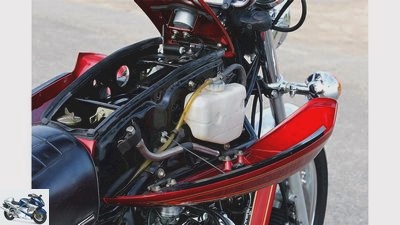
38/48
Clever: The dummy tank houses an expansion tank and tool / glove compartment.
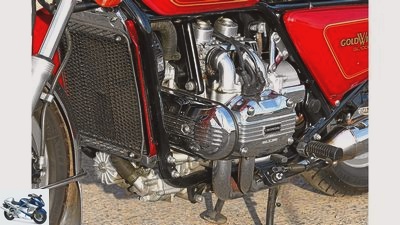
39/48
Visionary: XXL water cooler and toothed belt drive for the ohc camshafts.
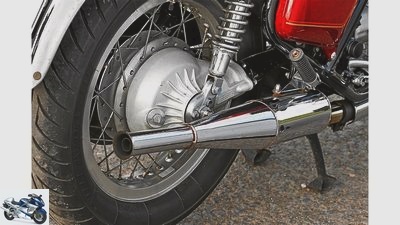
40/48
Clean: Honda’s first cardan machine; Spoked wheels meet retrofit exhausts.
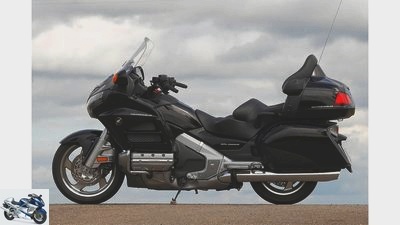
Bilski
41/48
Honda Gold Wing (2015).
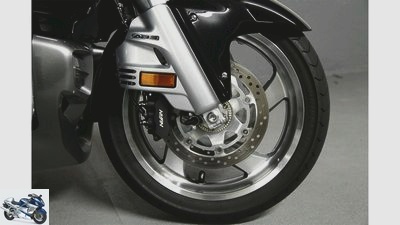
Blacksmith
42/48
Typically Honda: Combination brake (in both directions) with three-piston floating calipers.
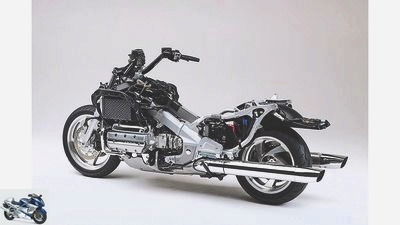
Honda
43/48
Almost hidden from the eye: aluminum bridge frame, single swing arm, side radiator.
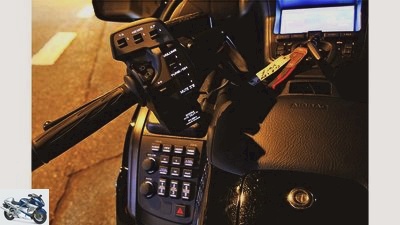
Blacksmith
44/48
Illuminated switches and buttons to operate the cluttered fittings at night.
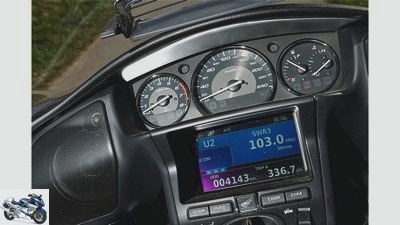
Rivas
45/48
Unadorned watches, large information board, ventilation flap in the window.
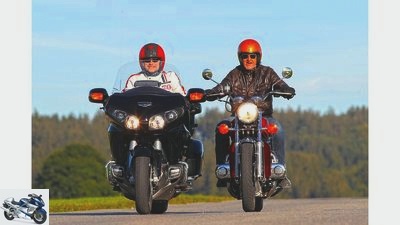
Bilski
46/48
40 years of the Honda Gold Wing.
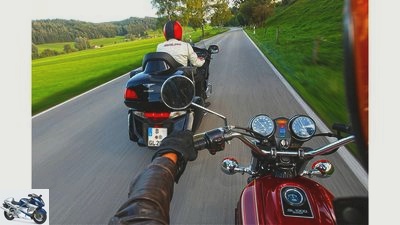
Bilski
47/48
Looking forward …
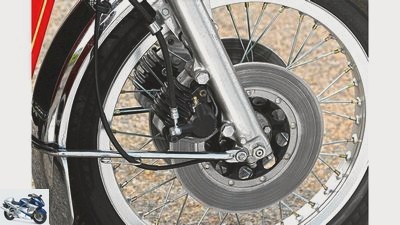
48/48
More was not possible: three disc brakes, floating calipers in front.
Harley-Davidson Electra Glide, Honda Gold Wing and Yamaha Vmax
Legends celebrate an anniversary
Three rolling icons, sculptures on wheels, are celebrating a milestone birthday in 2015. Motorcycles that almost everyone knows, together a full 120 years of cult. MOTORRAD congratulates the Harley-Davidson Electra Glide, Honda Gold Wing and Yamaha Vmax and compares the original versions with the current models.
"To exist means to have ancestors", says a proverb from Cameroon. Well, that’s not the only reason Harley-Davidson are Electra Glide, Honda Gold Wing and Yamaha Vmax are very living beings. They look back on an impressive 50, 40 and 30 years of history.
Buy complete article
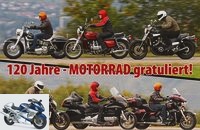
Harley-Davidson Electra Glide, Honda Gold Wing and Yamaha Vmax
Legends celebrate an anniversary
Comparison of tradition and claim
The milestone anniversaries are an occasion for a search for traces, a comparison, a comparison of tradition and claim: How much do the current machines still breathe of the spirit of the original versions? Do they still stand for the same basic philosophy? After all, after such long periods of time for the motorcycle world, a completely different direction may have been taken in retrospect. Only those who know where they come from know where they are going. What is the legacy, what is the DNA of these three types? Because “tradition is keeping the fire and not worshiping the ashes”, says a popular saying.
This also applies to the motorcycles with history united here and all the stories with motorcycles that hundreds of thousands, probably even millions of people around the world have experienced with them. Harley-Davidson Electra Glide, Honda Gold Wing and Yamaha Vmax have brought a lot of movement with them in a total of 120 years – both mechanically and emotionally. But now the classic meets the modern, cooling fins crackle, hearts bounce with these six gems. Because today is tomorrow’s yesterday.
Harley-Davidson Electra Glide – 50 years!
Bilski
Milwaukee motorcycles have been shaped by tradition and style since 1903. And the Electra Glide has been an icon for half a century. It is the epitome of the American Dream on two wheels and is probably the most famous motorcycle in the world.
The name itself is legend: Electra Glide. As American and sonorous as Corvette, Cheeseburger and Coca-Cola. A motorcycle that has been electrifying for 50 years, one that arouses longing. But it wasn’t a completely new design: In 1949 the Hydra Glide was the first Harley with a hydraulic telescopic fork. In 1958 it was replaced with the rigid frame by the Duo Glide with two hydraulically damped struts. Which then advanced to the Harley-Davidson Electra Glide in 1965, upgraded by the electric starter, in addition to the kick starter. Now everyone could bring the mighty V2 engine to life.
The Electra Glide Harley’s first motorcycle with a twelve-volt electrical system and a huge, thickly paneled 32-Ah battery. At the same time, the Harley-Davidson Electra Glide was the last Harley with a Panhead V2, named after its distinctive, smooth-surfaced cylinder head covers – like upturned pans. Our 1965 copy, delivered by Harley-Davidson Hamburg Nord (thank you guys!), Had a V2 that was 17 years old at the time and was presented immodestly in 1948 as the most modern motorcycle engine worldwide! 1206 cm³, aluminum heads and hydraulic valve clearance compensation were formerly state of the art, cutting edge technology.
Historic Electra Glide looks simpler
This big bike from yesteryear looks beguilingly clean. Is the luscious Ultra Limited really the great-great-grandson? Well, Harley kept the familiar shapes of many of the assemblies through all of the model changes since then. Like the cut of the typical sheet metal fenders, the bulky coverings of the fork tubes, the parallelogram-shaped, narrow GRP cases (standard white, not black), running boards or the fat box for the primary drive on the left side of the engine. But although it dictated the basic style, the historic Harley-Davidson Electra Glide seems simpler.
A large-volume V2 engine, a huge lamp and two balloon tires on wire-spoke wheels, the basic recipe was that simple. This Hamburg ornament – it stood for many years – was brought out of its slumber especially for this appointment, beguiled by what is not on it: No typical additional headlights left and right with indicators mounted underneath (are subsequently stripped), no window, not even that thickly padded, sprung double seat “Super Deluxe Buddy Seat” is on board. A freely floating, but ergonomically perfectly tailored, solo swinging saddle does the same. Harley-Davidson already fulfilled special requests ex works 50 years ago, with plenty of chrome parts including cigarette lighter!
Be a man, ride a pan!
Ignition on, using the rotary switch on the chrome-plated tank console – it was standard on Harley touring bikes as early as the 1950s. Open the brass petrol tap on the front left on the two separate tank halves, press the button – nothing. The starter freewheel spins. So kick it, look for top dead center, kick with smack, step on the gas, give the cylinder duo high octane with the single carburetor. And so reanimate the venerable lady with gentle force. She sweats gasoline here, oil there. Old age incontinence. Still, it works, it comes. The Harley-Davidson Electra Glide is running! And how. The earth shakes, the air filter rattles, the engine crackles, the fishtail end piece of the 2-in-1 exhaust blows a storm. Acoustically, a lot of Rabatz! Targeted throttles keep the V2 alive.
This is still an internal combustion engine made from old grist and grain. You’re more of a machinist than a driver, and you’ve got your hands full. “Be a man, ride a pan!” Now don’t make a mistake when getting on. The curved handlebars of the Harley-Davidson Electra Glide are great to hand, and the cheerfully bouncy saddle is really comfortable. Very relaxed and yet compact, the whole thing, close to the action. It rages beneath you like a wild animal in a cage. You pull the clutch lever, phew, that’s difficult. The “Mouse Trap” sits on the lower left frame support. This release mechanism for the clutch came with the first series footshift for Big Twins (the last Panheads were optionally available with manual gearshift and foot clutch!). Less effort was probably not wanted.
Press the button once and the injector is there
First gear gently engages. In this example it is on top, the other aisles are on the bottom. The six hundredweight load begins to move, yes, it drives! The old engine runs archaically, metallic. But mechanically top: The four bumpers and valves tick quietly. That has soul and even real bang for that time. You cheer with happiness, inhale every single meter, want to embrace the world. That’s a great feeling. Motto: as much experience as possible per kilometer, in every respect. The Harley-Davidson Electra Glide runs reasonably well on its car tires, which means tread and format. It is even very stable in curves for its era. In contrast, the current 1700 seems almost unspectacular. Press the button once and the injector is there, kawumm, runs smoother, more whispering.
Only when idling does the big, clean V2 heart shake, stomp back and forth, shake its vibration-reducing rubber mount. Clone! The transmission of the Harley-Davidson Electra Glide looks more rustic than it did 50 years ago, accentuating every shift. And just serve six courses. The hydraulic clutch is easy to pull, and the dosage is great. A cooling water jacket has been around the hot outlet valves since the end of 2013. The associated water coolers are cleverly hidden in the leg shields. “Twin-Cooled” is what Harley calls this combination of air and water cooling. Break in style on an icon? Technically sensible. The toothed belt-driven slider hangs softly and elastically on the e-gas – the old one still has a duplex chain and cable, of course. The modern long stroke (111.1 millimeter stroke) with bumpers pushes gently but firmly.
A statement on wheels
Above 3000 tours the valve in the right exhaust, the one with more passage, opens. Now the sound becomes fuller, bassier. The suction snorkeling is low-frequency anyway. He’s got something, this two-wheeled road cruiser, is easy to handle beyond walking pace. He needs to run out in front of the front wheel, looks for empty streets, feels even better in the USA. But it’s also a big show on busy German streets. 50 years ago nobody would have believed that the American brand would come in third place for new sales in Germany. A Harley remains a commitment to being different, a statement on wheels, no matter how many others ride one.
The sweeping Batwing cladding has been a style-defining feature since 1969; It was revised in 2013. Now a lockable flap regulates the air supply of the modern tourer with the classic silhouette. What does this 421 kilo “full dresser” par excellence not have on board? Bluish daylight shining LED headlights, huge Tourpak top case, crash bar packages, wing chairs for the pillion passenger, powerful 50-watt speakers front and rear for stereo surround, 6.5-inch touchscreen including top navigation system, ipod / USB connection … USB? There used to be only USA.
Brakes? What brakes?
On both Harleys the landscape pulls by in widescreen format. But they emphasize “entertainment” differently. Then as now, all roads lead to chrome. Sparkling, the high-quality new product at 30,000 euros remains true to the line. The time has come, a Harley has to be praised for its braking power. The new deceleration from 40 km / h is electronically controlled in the combination front / rear. Brakes? Which brakes? Doesn’t know the old Harley-Davidson Electra Glide.
The almost ineffective front half-hub drum of the Harley-Davidson Electra Glide is something for people who believe in rebirth, despite the hydraulically operated rear drum. Even approaching an intersection is a real challenge. Let’s be mild: the Panhead-Electra Glide, one of only 6930s built, had it tough enough. As early as 1966, after just one year, the Early Shovel came out, with shovel-shaped cylinder heads. The current E-Glide will certainly stay on Harley’s top tourer for longer.
Technical data Harley-Davidson Electra Glide
Bilski
Harley-Davidson Electra Glide (Panhead, 1965).
Harley-Davidson Electra Glide (Panhead, 1965)
Air-cooled two-cylinder four-stroke 45-degree V-engine; an underlying camshaft, two valves per cylinder; Bore x stroke 87.3 mm x 100.8 mm; 1207 cc; 44 kW (60 PS) at 5400 rpm; 88 Nm at 3500 rpm; Compression 8.0: 1, Linkert carburetor 1 x Ø 38 mm; Four-speed gearbox, multi-plate oil bath clutch; Chain; Double loop pipe frame made of steel; Telescopic fork, Ø 41 mm; Two-sided swing arm made of steel; two directly hinged struts; Drum brake in front, Ø 200 mm; hydraulically operated rear drum brake, Ø 200 mm; 5.00 x 16, 5.00 x 16 tires; Wire spoke wheels made of steel; Wheelbase 1562 mm; Length 2.33 meters; Seat height 760 mm; Weight with a full tank 315 kg; Tank capacity 18.9 liters; Price (1965) $ 1,595 (that’s about $ 14,000 today)
Gargolov
Harley-Davidson Electra Glide Ultra Limited (2015).
Harley-Davidson Electra Glide Ultra Limited (2015)
Water / air cooled two cylinder four stroke 45 degree V engine; two underlying camshafts, two valves per cylinder; Bore x stroke 98.4 mm x 111.1 mm; 1690 cc; 64 kW (87 PS) at 5100 rpm; 138 Nm at 3750 rpm; Compression 10.0: 1, injection 2 x Ø 46 mm; Six-speed gearbox, multi-disc oil bath clutch; Timing belt; Double loop pipe frame made of steel; Telescopic fork, Ø 49 mm; Two-sided swing arm made of steel; two directly hinged struts; Double disc brake at the front, Ø 300 mm; Four-piston fixed callipers, rear disc brake, Ø 300 mm; Four-piston fixed caliper; Tires 130/80 B 17, 180/65 B 16; Cast aluminum wheels; Wheelbase 1625 mm; Length 2.47 meters; Steering head angle 64 degrees; Caster 170 mm; Spring travel front / rear 117/76 mm; Seat height 760 mm; Weight with a full tank 412 kg; Tank capacity 22.7 liters; Price from 29,045 euros
The facts:
Bilski
Harley-Davidson has been building V2 machines continuously for 106 years.
• Displacement: plus 40 percent
• Performance: plus 45 percent
• Torque: plus 56 percent
• Weight: plus 30 percent
Myth with tradition: Harley-Davidson has been building V2 machines continuously for 106 years. In 1909, 27 copies of the 5D model were made. The very first V-Twin, designed by William Harley, provided the typical 45-degree cylinder angle. The electric starter of the Harley-Davidson Electra Glide was an heirloom in 1965, the three-wheeled Servi-Car received it as early as 1964 – it was built as the longest-lasting model by Harley-Davidson with a lot of facelift from 1932 to 1973. Harley literature is inflationary. In keeping with their 50th birthday, the trio of authors Haarschneider, Heil and Christmann published the volume “Touring” in the HD book series by Huber Verlag. For 16.90 euros it is a profound, beautiful read on the subject of E-Glide and Co. Specialists in historical Electra Glides are the Harley-Factory Frankfurt (Tel. 069/4089990069/4089990), Harley-Davidson Hamburg Nord (Tel. 040 / 4130300040/4130300) and Jurgen Ullrich (Juergen@Harley-Davidson-Museum.de).
You’ll need Skype CreditFree via Skype
Honda Gold Wing – 40 years!
Bilski
Gold Wing is more than a name. It’s a touring dream on wheels. With their appearance, anything was possible in the motorcycle world, including absolute reliability. At first, the 1000 was misunderstood as an athlete.
Cologne 1974. There is a sensation at the IFMA: The Honda GL 1000 Gold Wing trumps every previous series machine. Incredible: 999 cm³, distributed over four water-cooled cylinders. Their short-stroke boxer power pack weighed 106 kilograms and promised a full 82 hp, more than a Kawasaki Z1! New territory: camshaft drive via two toothed belts. This was only possible in cars before. Clever: compact gearbox and lowering the center of gravity under the crankcase. This, not Kawasaki’s Z 1000, was Japan’s first 1000, a true superbike. Innovative: The alternator rotating in the opposite direction to the one-piece forged crankshaft suppressed wobbly back torque when changing gas.
In addition, there was the first Japanese secondary drive with a cardan shaft. And for the first time three disc brakes in a production motorcycle. No question about it, a comet had risen from the Honda house. He opened up new dimensions. It could have been even bigger. Because as early as 1972, the world’s largest motorcycle manufacturer was experimenting with a water-cooled six-cylinder boxer in the project, which was internally named M1 (later AOK)! It had a displacement of 1470 cm³ and anticipated, naked, what was only presented in 1988 in the form of the GL 1500/6 lavishly fully disguised – again at the IFMA in Cologne. Why the Honda GL 1000 Gold Wing appeared as a four-cylinder after all?
Sound is reminiscent of VW Beetles
Apparently in the early 1970s there were still problems getting the driver close enough to the handlebars with such a long engine. Perhaps the disaster of the Ducati Apollo also played a role: In 1963, two prototypes with 1260 cubic V4s were created! But under its 100 hp, the tires of that time crumbled, mass production was out of the question. Either way, Honda had studied in peace. And packed enough superlatives in a single motorcycle, the Honda GL 1000 Gold Wing. In the triangle frame, it stores the fuel (the 1800 still does that today), the supposed tank is a luggage and glove compartment and houses the cooling water expansion tank.
The splash guard on the front, chrome-plated fender with a stylish retaining strut shields the water cooler from stones. Electrical lines are laid cleanly inside the tall handlebars (there was an even higher one for the USA). Honda has thought of everything and finally brought automotive-like perfection to motorcycle construction. This is proven by the first push on the button at the latest. Even when it’s cold, you don’t need the choke, which is conveniently mounted on the handlebar. The smoothness of the four-cylinder boxer’s engine was impressive from the start. The Flat-Four whispers discreetly. Its sound is reminiscent of the VW Beetle – in America there were bizarre attempts to install the VW engine in motorcycle chassis as early as the 1960s.
Sports tourers or super athletes?
But even in Europe it was not clear when the 1000 Gold Wing was published: Is it a super tourer or a super athlete? MOTORCYCLE veteran “Mini” Koch talks about 1000cc Hondas with M handlebars and set back footrests at the time. And motorcycle legend Franz-Josef Schermer remembers the infamous pendulum tendency of the first Golden Swings: “I pushed at full throttle, almost 190 km / h, through a long motorway curve, suddenly there were bumps and I needed the entire lane to get around the Honda To keep the Gold Wing on the road and not to fly over the central guardrail into the oncoming lane. ”Honda only gradually improved the weaknesses of the chassis.
Nevertheless, the brawny 1000 cardan tourer even mutated into an endurance racer in 1976! But only with a new perimeter frame and central spring strut with deflection system. The sumo racer took a great fifth place at the Spa-Francorchamps 24 Hours in 1976, see MOTORRAD Classic 3/2015. Well, we’re moving a beautiful serial machine here. It is a US model from 1977. Gran Tourismo. For owner Max Balazs, who is only 27, it was “love at first sight”. It cannot tarnish even a meager 179 kg payload. The unfortunate misplaced and therefore difficult to dose cable clutch of the Honda Gold Wing needs a lot of strength. The boxer pushes emphatically at medium engine speeds.
A real beauty, this Honda GL 1000 Gold Wing
It is understood that this engine inspired dreams. Just like its four- and six-cylinder successors (GL 1100 from 1980, GL 1200 from 1984, GL 1500 from 1988, GL 1800 from 2001). A real beauty, this Honda GL 1000 Gold Wing. You still understand their technology intuitively, you can see intake manifolds and shiny manifolds. In contrast, the exclusive drive of the 1800 series, which was released in 2001, remains completely hidden from the eye. The same goes for the shafts, in which timing chains continue to drive just one overhead camshaft and each of these drives two valves per cylinder. This is absolute opulence on wheels – two rooms, kitchen, bathroom. The travel giant inspires with a unique, not too loud sound, resembles an older BMW M3 when it is turned off.
Clearly: This is the smoothest running, silkyest of all motorcycle engines, sorry BMW K 1600! As if the cylinders were lined with velvet and silk, the crankshaft, which is positioned lengthways to facilitate handling, would turn in butter. The sensitive hydraulic coupling of the Honda Gold Wing helps a lot: As with every ocean liner, turning maneuvers and maneuvering when mooring and casting off in port are the most delicate maneuvers. But even small riders can safely reach the ground and the handlebars that come far in the opposite direction. Only those who have never parked downhill with this 425-kilo colossus blaspheme about the reverse gear driven by the starter. The five forward gears click in typical Honda.
The original version reacts much more sensitively in an inclined position
Power? Let’s quote Rolls-Royce: enough. 130 Newton meters at 2000 tours. Any questions? Power to weight here means both parts of the word. In overdrive, 2600 tours are enough for 100 km / h, the original Gold Wing also needs a moderate 3500. It’s amazing how nimble and precise the luxury steamer circles through serpentines and underground garages. It’s just a Honda, perfectly balanced. The giant can curve, even well, rolls smoothly and evenly through alternating curves. The 1000, which is over 130 kilograms lighter, falls at least as easily into a lean position on its narrow tires. But the original version reacts much more sensitively to disturbances, potholes and bumps in an inclined position: its suspension struts, yes, the entire frame, seem overwhelmed when the ride is too brisk.
Hey, those are gliders too! Sit on it and feel good, enjoy the landscape in a relaxed way. Miles & more. Blessed with mechanically eternal life. Protected or shielded on the new one, everyone should know that for themselves: central locking and remote control for the inside somewhat small top case, 55 switches, buttons and controls (illuminated at night) act like a jet cockpit. The world’s first motorcycle airbag provides safety as standard. The more leisurely, more sensitive 1000 is more pure and puristic. The ex-superbike is now a good-natured buddy. Its brakes need more manual power than the current compound stoppers.
In November 2014, after 65 years of motorcycle construction, a Gold Wing was Honda’s three hundred millionth motorcycle. What a production anniversary. What do wingers want for the future? First an electrically adjustable disc: stopping to release two locks is old-fashioned, not very confident. Many would like a dual clutch transmission (DCT) for the smoothest gear changes. In addition, slightly better brakes and possibly more appealing spring elements – everything is as of 2001. Oh yes, a little fewer switches for the driver and wind turbulence for the pillion would be nice. Plus more payload. Rumor has it that something will come in 2017. Hello, Honda, please let the next Gold Wing set standards again! Like for 40 years.
Technical data Honda Gold Wing
Bilski
From four to six cylinders, from 999 to 1832 cm³.
Honda Gold Wing 1000 (1975)
Water-cooled four-cylinder four-stroke boxer engine; one overhead camshaft, two valves per cylinder; Bore x stroke 72.0 mm x 61.4 mm; 999 cc; 60 kW (82 hp) at 7500 rpm; 80 Nm at 6500 rpm; Compression 9.2: 1, four vacuum membrane carburetors, Ø 32 mm; Five-speed gearbox; Multi-disc oil bath clutch; Cardan; Double loop pipe frame made of steel; Telescopic fork, Ø 37 mm; Two-sided swing arm made of steel; two directly hinged struts; Double disc brake at the front, Ø 232 mm; Single-piston floating calipers, rear disc brake, Ø 250 mm; Single-piston floating caliper, tires 3.50 H 19, 4.50 H 17; Wire spoke wheels with aluminum rims; Wheelbase 1545 mm; Length 2.33 meters; Steering head angle 62 degrees; Trail 120 mm; Spring travel front / rear 120/87 mm; Seat height 820 mm; Weight with a full tank 295 kg; Tank capacity 19.0 liters; Price (1975) 9,269 marks
Honda Gold Wing (2015)
Water-cooled six-cylinder four-stroke boxer engine; one overhead camshaft, two valves per cylinder; Bore x stroke 74.0 mm x 71.0 mm; 1832 cc; 86 kW (117 hp) at 5500 rpm; 167 Nm at 4000 rpm; Compression 9.8: 1, injection, 6 x Ø 40 mm; Five-speed gearbox + reverse gear; Multi-disc oil bath clutch; Cardan; Bridge frame made of aluminum; Telescopic fork, Ø 45 mm; Single-sided swing arm made of aluminum; Central spring strut with lever system; Double disc brake at the front, Ø 310 mm; Three-piston floating calipers, rear disc brake, Ø 316 mm; Three-piston floating caliper, tires 130/60 R 19, 180/55 R 17; Cast aluminum wheels; Wheelbase 1707 mm; Length 2.66 meters; Steering head angle 60.2 degrees; Caster 114 mm; Spring travel front / rear 140/105 mm; Seat height 740 mm; Weight with a full tank 425 kg; Tank capacity 25.0 liters; Price 32,255 euros (including additional costs)
The facts:
Bilski
Looking ahead: what has changed after 40 years of development?
• Displacement: plus 83 percent
• Performance: plus 43 percent
• Torque: plus 108 percent
• Weight: plus 43 percent
Almost half a million copies of the Gold Wing models with 1000 to 1500 cm³ were made between 1975 and 2001, exactly 486,598. There are also around 200,000 copies of the 1800s, i.e. around 700,000 Honda Gold Wings! Further information: www.goldwing-forum.de, www.gl1000.de and MOTORRAD Classic 7, 8/2015.
Contact persons are the active Gold Wing Club Deutschland e. V. (www.gwcd.de), the international Goldwing Road Riders Association e. V. (www.gwrra.org) and the Goldwing Federation Germany e. V. (www.gwfd.de) as the umbrella organization of the German gold wingers. Europe’s largest Gold Wing dealer, Biker’s Point Fuchs in Uslar, Lower Saxony (www.goldwing.de), always has dozens of new and used Über-Hondas in stock. The standard work is the book “Honda Gold Wing” by the authors Petri and Koenigsbeck (only in the second-hand bookshop), there is now “Honda Gold Wing: History of a cult motorcycle” by Pascal Szymezak (Heel-Verlag). Nice stories and photos (not only about the Nippon cult) can be found at www.winni-scheibe.com
Yamaha Vmax – 30 years!
Bilski
In itself, the drag strip race, the full acceleration over the quarter mile (402 meters), is a quintessentially American type of motor sport. But just a production motorcycle from Japan was perfect: the Yamaha Vmax. It turns on in Europe too.
Handiness, passenger comfort, consumption? Forget it! When Yamaha put together the first ideas for the Yamaha Vmax, one single point was firmly in focus: speed. And straight ahead. This motorcycle should (b) run. The quarter mile in view, a good start, full acceleration and then leaving every other production bike behind. But the future drag queen first needed a daring organ transplant: a good 30 years ago, the Yamaha engineers transplanted the then most powerful engine from their own range, the XVZ 12 T. That was a 1983 super tourer with 98 hp and powerful full fairing , like Yamaha’s Gold Wing.
Sharper camshafts and larger valves with reinforced springs made the Tourer V4 with a cylinder angle of 70 degrees more powerful. There were also lighter pistons, stronger connecting rods and an adapted crankshaft. But in order to finally blow up the 1200cc V4, the Yamaha engineers installed an exclusive trick, the V-Boost: The intake ducts of the opposite cylinders of both cylinder banks are connected by a cross tube. A servomotor, which can be heard humming when the ignition is switched on, gradually opens the throttle valve located in it from the magic speed of 6000. From 8000 tours, the complete cross-section is released – and the respective suction cylinder is ventilated by two carburetors.
V4 needs some choke
Then the signs point to storm, for the standards of that time an insane 145 hp should be available, with still moderate 9000 tours. Because if more gasoline improves the filling, the previously hand-tame Vau-Vier becomes a mighty tearing projectile. However, this only applies to Vmaxes who came to Germany via North America. In this country the red card was given for full performance, the V-Boost was omitted and reduced to 98 PS (“open” 120), pardon me: throttled. Paradox: In the USA the Yamaha Vmax could openly blow around, but it was never allowed to be fast, given the limit of 55 miles per hour, about 88 km / h, which was then everywhere there. This is why our machine’s speedometer, which is highlighted in white, has a distinctive red 55.
Owner Thomas Heim provided us with his ’96 US model. Because the drive is identical to the original 85 version, but the newer already has the improvements from 1993 on board: a stiffer, thicker telescopic fork and snappier brakes from the FZR 1000. The V4 needs a little choke (left on the carburettor), grumbles wonderfully in front of it down. Black chrome-plated exhausts spread an angry, martial aura. Immediately counter the brushed aluminum and subtle chrome jewelry. The right step follows the successor. V4 engines feel different, rev up in their own unique way, are grumpier. Many Aprilia, Honda and Yamaha riders know this. But to experience it on the Yamaha Vmax is another experience.
Mechanically, the V4 sounds completely healthy, never strained
The engine has warmed up, the gas handle at the end of the town is fully open, now it’s time! Madness. Even by today’s standards, the old Yamaha Vmax pushes hard. Such a boost from the 6000 mark, that rocks! Really reminds of a turbo. Unleashed wildly, the tachometer needle storms towards the red light district at 9500 tours, the V4 roars wildly. Shift quickly. Mechanically, the V4 sounds completely healthy, never strained. This is clearly the fittest of the three oldie engines. No wonder that in 1985 so many legends and myths revolved around the Vmax, this frosted beast.
Today, with a lot of experience, you have to acknowledge: this Yamaha Vmax and its 1200 power cube always give you two options – cruising through the city in a cool and relaxed manner or savoring the V-Boost punch on every short straight in between. Puberty, but great. As Thomas Heim said: “Normal motorcyclists say: There was a straight line between the two curves.” But with Vmax drivers (recently 1000 of them from all over Europe met in Alsace for their 30th anniversary!) It is the other way around: “ There was a curve between two straights. “
2.7 seconds for the sprint from 0 to 100
But it comes even more powerful, much more powerful. The current Yamaha Vmax follows exactly in these footsteps. Man, is she fat. Nothing comes from anything: The increases in weight and dimensions are moderate compared to the two other traditional pairs, from 279 to 310 kilos in weight and from the not short 1.59 meters to a full 1.7 meters wheelbase. You sit much broader-shouldered and broader-legged, right in the middle of the hustle and bustle, on the old Vmax the sitting position with high knees behind the narrow handlebars is undecided, not half as confident as the V4. Steam announcement: The new one sucks in air through air scoops the size of a ship’s chimney, the slimmer historical ones are just mockups.
Sure, because in 2008 the new model was the first series machine to break the 200 hp limit, and there are well over 190 horses in the stable here. From idle, the 1700 beast below you shovels mountains of torque onto the rear tire. But stay tame in the city with a little restraint on the throttle. The Yamaha Vmax can be surprisingly gentle. But woe if you let go of the new dominant rev counter reports more than 4500 rpm. The halved V8 (with 65 degree cylinder angle) hums, damn it, like a whole. With such a displacement and specially adapted maps, the thrust from the 6000 mark is brutal. Vehement, incomparable. As if Thor were swinging the hammer personally: 2.7 seconds for the sprint from 0 to 100 cannot be beaten, a record for MOTORRAD.
The 1700 is sturdy on the track
Wheelies? Pah, nothing stands out in front. At most it goes crazy. Because the grenade on wheels does not have traction control. It’s just a men’s motorcycle, not a children’s toy. Be careful if the rear wheel suddenly wedges in a full lean position (because of the wide 200 mm tail slap, the new one needs more of it at the same speed). This performance can also be casual, you don’t have to prove anything: In the still final fifth gear, the Yamaha Vmax rips from 60 to 140 in 6.5 seconds. The 1700 is rigid on the track, but already seals off at 220. Vmax? Not so important with the Vmax. Then as now, durable cardan drives provide the rear wheel with power – previously weak, now powerful.
What both Vmaxe have in common is the sheer pleasure of accelerating, sprinting. The advantage of the new? The chassis suits the engine performance better. Six-piston stoppers and an ABS save in an emergency if you misjudge yourself when accelerating. The current Yamaha Vmax is a modern, stable motorcycle that drives in exactly the same way: the stiff suspension strut (only one today, no longer two) never leaves you in the dark about bumps. Feedback, tire grip – the old one naturally has the disadvantage in every discipline. After all, the 1200 remains stable and predictable on course with retrofitted black bearings in an inclined position. She was just a great achievement.
Then as now: once in a lifetime you should have fully accelerated a Yamaha Vmax. Then your soul flies into the light. Thank you, Yamaha, for this courage to go to extremes. But now: full throttle!
Technical data Yamaha Vmax
Bilski
From 70 to 65 degrees, from 145 to 200 hp. This is how the 96 and 2015 models differ.
Yamaha Vmax (1996)
Water-cooled four-cylinder, four-stroke, 70-degree V engine; two overhead camshafts, four valves per cylinder; Bore x stroke 76.0 mm x 66.0 mm; 1198 cc; 107 kW (145 hp) at 9000 rpm; 122 Nm at 7800 rpm; Compression 10.5: 1, constant pressure carburetor 4 x Ø 35 mm; Five-speed gearbox; Multi-disc oil bath clutch; Cardan; Double loop pipe frame made of steel; Telescopic fork, Ø 43 mm; Two-sided swing arm made of steel; two directly hinged struts; Double disc brake at the front, Ø 298 mm; Four-piston fixed callipers, rear disc brake, Ø 282 mm; Two-piston fixed caliper; 110/90 V 18, 150/90 V 15 tires; Cast aluminum wheels; Wheelbase 1590 mm; Length 2.30 meters; Steering head angle 61 degrees; Caster 119 mm; Spring travel front / rear 140/100 mm; Seat height 800 mm; Weight with a full tank 279 kg; Tank capacity 15.0 liters; Price (1996) 18,230 marks
Yamaha Vmax (2015)
Water-cooled four-cylinder four-stroke 65-degree V-engine; two overhead camshafts, four valves per cylinder; Bore x stroke 90.0 mm x 66.0 mm; 1679 cc; 147 kW (200 hp) at 9000 rpm; 167 Nm at 6500 rpm; Compression 11.3: 1, injection, 4 x Ø 48 mm; Five-speed gearbox; Multi-disc oil bath clutch; Cardan; Aluminum bridge frame; Telescopic fork, Ø 52 mm; Aluminum double swing arm; Central spring strut with lever system; Double disc brake at the front, Ø 320 mm; Six-piston fixed callipers, rear disc brake, Ø 298 mm; Single-piston floating caliper, tires 120/70 R 18, 200/50 R 18; Cast aluminum wheels; Wheelbase 1700 mm; Steering head angle 59 degrees; Trail 148 mm; Spring travel front / rear 120/110 mm; Seat height 775 mm; Weight 315 kg; Tank capacity 15.0 liters; Price 19,790 euros (including additional costs)
The facts:
Yamaha
Strong: The “Boost”, the connection of the intake paths of both cylinder banks, gets you moving from 6000 rpm!
• Displacement: plus 40 percent
• Performance: plus 38 percent
• Torque: plus 37 percent
• Weight: plus 13 percent
Need for speed: In the early 80s, Akira Araki explored the US motorcycle market on behalf of Yamaha. His most impressive experience: Bridge Races. Two bikers, one bridge. Whoever arrives first over there wins. The basic idea for the Yamaha Vmax matured. It was presented in 1985. Rapid, radical, 145 horses strong. Officially, it did not come to Germany until 1996, throttled to 98 hp. Up until then (and afterwards) gray imports flourished. Whole shiploads of Vmaxe came to us from the USA and were approved by individual acceptance.
The Yamaha Vmax officially found 6710 buyers until 2005. The current version followed in 2008. Even stronger, even more impressive. She has found 723 lovers to date. Many specialists took on the Vmax in order to heal small weaknesses, such as Emil Schwarz (www.emilschwarz.de). Meeting point on the net for all Vmax disciples: www.vmaxxers.net.
Conclusion
Bilski
Together they celebrate the one hundred and twenty anniversary. But whether the great-great-grandchildren adequately appreciate it?
“Open your arms to change, but don’t lose sight of your values,” said the Dalai Lama. The historical machines all come from a time when the world was not very digital, Europe was not unified and life was a little slower. The decades have not left their mark on the founders of ideas of yore. The current keepers of tradition are more suitable for everyday use, more user-friendly and safer. Better chassis, snappier brakes, ABS and fuel injection are major advances. You can be divided about everything around it. Especially the Honda Gold Wing and Harley-Davidson Electra Glide seem almost overloaded with equipment, the Honda with switches.
They are also much heavier than they were before, for older customers. Their less voluptuous ancestors radiate a different charm: reduced to the essentials, driving. Today, Harley’s Road King and – apart from the final drive and engine design – Honda’s CB 1100 EX breathe the spirit of the ancestors. We have to acknowledge the many constructive advances made by the apparently little tech-savvy Harley-Davidson brand. With the Hondas, changing the number of cylinders is not a style break, but only logical. A Honda Gold Wing always had the smoothest engine of its time. However, a 1000 was more modern in 1975 than the 1800 is today. The Yamaha Vmax has consequently remained the most faithful in terms of its concept and its key data.
Related articles
-
Harley-Davidson Street Glide and Honda Gold Wing F6B put to the test
Gargolov 31 pictures Gargolov 1/31 Front as shortened with a scythe, rear as compressed with a hammer: excavators look strangely pretentious and are in the …
-
Klaus H. Daams 26 pictures Klaus H. Daams 1/26 This is where motorcycle history meets. Klaus H. Daams 2/26 “LTD” insignia: Maroon paint, golden rims …
-
On the move with the Honda GL 1000 Gold Wing
Jahn 11 pictures Jahn 1/11 In view of the enlightening driving impressions with the Honda Gold Wing from 1977, many old prejudices have to be straightened out ….
-
Cult bike Honda GL 1000 Gold Wing
Archive 6 pictures Markus Jahn 1/6 Markus Jahn 2/6 Honda 3/6 Travel motorcycle with smooth running and comfort: the Honda GL 1000 Gold Wing from 1974. Archive 4/6 With …
-
Honda GL 1000 Gold Wing and Munch-4 TTS-E 1200
fact 35 pictures fact 1/35 Honda GL 1000 Gold Wing and Munch-4 TTS-E 1200. fact 2/35 Nevertheless, the Munch is not as impassable as feared. Actually…
-
Ducati XDiavel S, Harley-Davidson V-Rod Muscle and Yamaha Vmax in comparison test
26 pictures 1/26 Harley-Davidson V-Rod Muscle, Yamaha Vmax and the new Ducati XDiavel S tested on the drag strip. …
-
On the move: Harley-Davidson Electra Glide old versus new
Wolf On the move: Harley-Davidson Harley-Davidson Electra Glide old versus new Content from Harley-Davidson is said to bring old technology at modern prices …
-
Comparative test BMW K 1200 LT, Harley-Davidson Electra Glide Ultra Classic, Yamaha XVZ 13 TF Royal Star Venture Beautiful living Eating kilometers, for two, …
-
Honda Gold Wing GL 1800 endurance test final balance
Jacek Bilski 34 pictures ADAC 1/34 I’ve never taken apart an engine that looked so good, here everything looks more like 5,000 than 63,000 …
-
Harley-Davidson Electra Glide Ultra Limited in the driving report
Jahn 16 photos Jahn 1/16 After 110 years of history, Harley-Davidson breaks its own tradition with the 45-degree V2 engine. First of all, all touring…